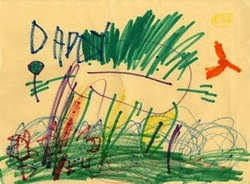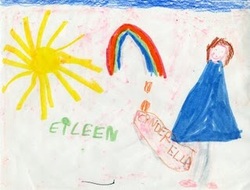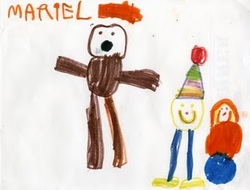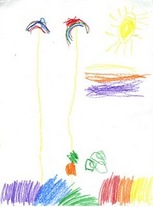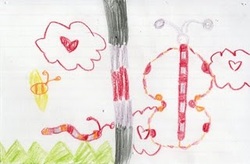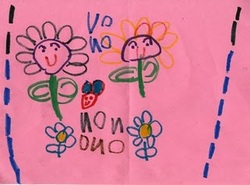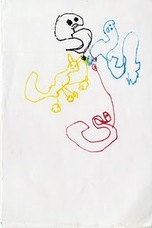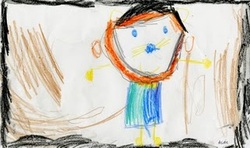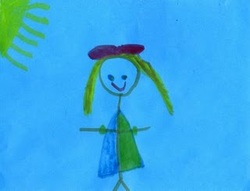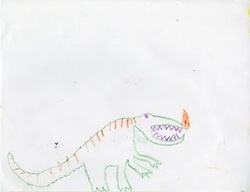The Preschematic Stage: Building a Visual Vocabulary
AGE: 4-7 YEARS
The second stage of artistic development, referred to as the preschematic stage (Lowenfeld), is a continuation of mark-making. Children in Early Symbol Making (Kerlavage), begin searching for representational schema and often create their own symbols to communicate visually. These symbols are representation of things, rather than things themselves. Once children master certain marks, they can then combine shapes to form symbols. These "me" drawings communicate meaning through representations of visual objects important to the child's life. In other words, children create economic equivalents for what they know of the world (Arnheim, 1969).
Characteristics to look for:
Characteristics to look for:
|
|
During this stage, symbols are constantly revised as children work to make them easier to read. Students also begin formal art instruction at school. In kindergarten, lessons revolve around play and story-telling. Over time, certain symbols become part of the child's repertoire. As they are combined to create pictures and stories, new symbols begin to appear.
Three of the earliest symbols include:
Three of the earliest symbols include:
1. Radial/Suns

After producing a series of mandalas, Annabelle produces a sun by extending radial lines from the center of a circluar yellow shape. Her ability to produce a confident circle with radial lines allows her to communicate clearly with this simple symbol. Her symbolic color choices help distinguish the sun from the other lines on the page. The object is large and place in the center of the page, giving it a powerful presence.
2. Simple Human Figures

In this benchmark drawing, Annabelle has produced one of her first representations of the figure. Centered on the page, the figure stands out as the focus of the drawing. This simple tadpole figure, is made by combining marks--a circular head, containing two eyes and a line mouth, and a rectangular body with straight lines radiating from the "neck" area. A series of multiple lines surrounds the figure, framing on the page.
3. Letter/Number Shapes
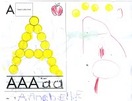
During the preschematic stage, children enter school. At school they are constantly exposed to letters, numbers, and the idea of putting them together to create words and sentences. This drawing is an example of Annabelle's letter mark making. The page required her to focus on making the letter "A," the first letter of her name. At the bottom of the page, she spellec her complete first name by drawing each letter in capitals.
|
This drawing is occupied by a simple human figure (Daddy?) The figure dominates a large portion of the page and is made by attaching arms to a large circular head. Fingers are added to the arms, which hold an object (a flower? lollipop?) An orange symbol (a bird?) floats next to the figure, while a yellow circle (the sun?) hovers overhead. The person is grounded in space by overlapping, most likely a representation of a field of grass and flowers. Annabelle also drew the word "Daddy" across the top of the page in large capital letters.
In this drawing (possibly for her mother), Eliana drew three prominent symbols--a sun, a rainbow, and a person. The sun is made by attaching radials to a circular shape. The rainbow does not include every roygbiv color, but the closely spaced arching lines represent a rainbow. At the right, the figure has a circular head containing eyes, a nose, and mouth. Eliana made deliberate decisions to switch colors when adding the hair, blue dress, and legs and feet. Arms are omitted from the figure. Eliana has begun to name her pictures by writing "Cinderella" next to her figure.
Mariel drew three figures on this paper. The first is a tall figure with a round head attached to a round body supported by two legs and balanced by two arms. The neck, hands, and feet of the figure have not been included. The next figure is a smiling face supported by legs and feet. The torso is omitted from the second figure. The third figure is made of a round head and round torso stacked on top of another round shape. Each figure is distinct and specific from each other. The middle figure wears a stripped hat on its head, while the figure on the far left is shown with an expressive O-shaped mouth.
A few symbols are organized on the page. A radial sun floats at the top right, and two rainbows appear in the top middle, connected to the bottom of the page by two vertical lines. A carrot-like object and green scribble (a rabbit?) hover above a bed of heavy multi-colored lines.
In this index card drawing, Eliana represented three different insects--a bee, a worm/caterpillar, and a butterfly. She also placed several green triangles side-by-side to show a specific environment (grass? mountains?) and divided the paper in half by stacking rectangular blocks of color (similar to those in the "Green and Blue Rectangles" drawing.) Hearts emerge as simple symbols and are contained within cloud-like forms. Colors are chosen according to personal preference.
|
In this drawing, Annabelle applied her facial schema to create figural flowers. These anthropomorphic flowers are drawn with local colors. Colorful petals spring from green stems and leaves. Two flowers, drawing in blue and yellow, help to balance the image. All of the symbols float on the pink paper. The letters "N" and "O" appear multiple times down the center of the drawing. Black and blue dashes running down the left and right sides of the page reinforce the drawings symmetry.
Cosimo's four firgures float at the top of the page. Drawn from imagination, they resemble ghosts and animals (cats, snakes, and fish) or possibly resemble favorite cartoon characters. There is no sense of conventional space in the drawing, but the figures closeness seem to indicate that they are interacting in some way (fighting? talking? touching?)
Asaie was asked to create a portrait of one of his classmates, Chenjia. He began by observing his classmate, and then became absorbed in his own work. His teacher occasionally asked prompting questions, such as "What parts are connected to the body?" "What color is his shirt?" and "Is his hair curly or straight? Long or short?" The goal was to include as many observed details as possible. The main figure is composed of a large, circular head and a square body. Arms are attached to the head and circles represent hands. Legs protrude from the body and feet are drawn using symbolic circles. After drawing his classmate, Asaie used his imagination to turn the figure into a "cat" by adding whiskers. Asaie framed the portrait by drawing heavy black marks along the edges of the page.
A single figure occupies the center of the blue paper. The blonde girl is wearing a detailed outfit: a blue and green dress with puffy sleeves and a large pink bow. This could be a self-portrait or simply the schema Eliana has developed to represent "a girl." In this drawing, Eliana has included a neck, but feet and hands have not been added. The yellow sun is confided to the top left corner of the picture.
Jiagu was given a blank sheet of paper and crayons to make this free drawing. With the secondary colors, he created this terrifying animal. Seen in profile, the drawing is a sophisticated representation of a dragon. The colors are fairly "realistic" and the fire-breathing animal stands upright on the bottom of the page, creating the first signs of a grounding baseline. The outstretched arms seem ready to move at any moment. With this drawing, Jiaju is on the cusp between the pre-schematic and schematic stages.
|
